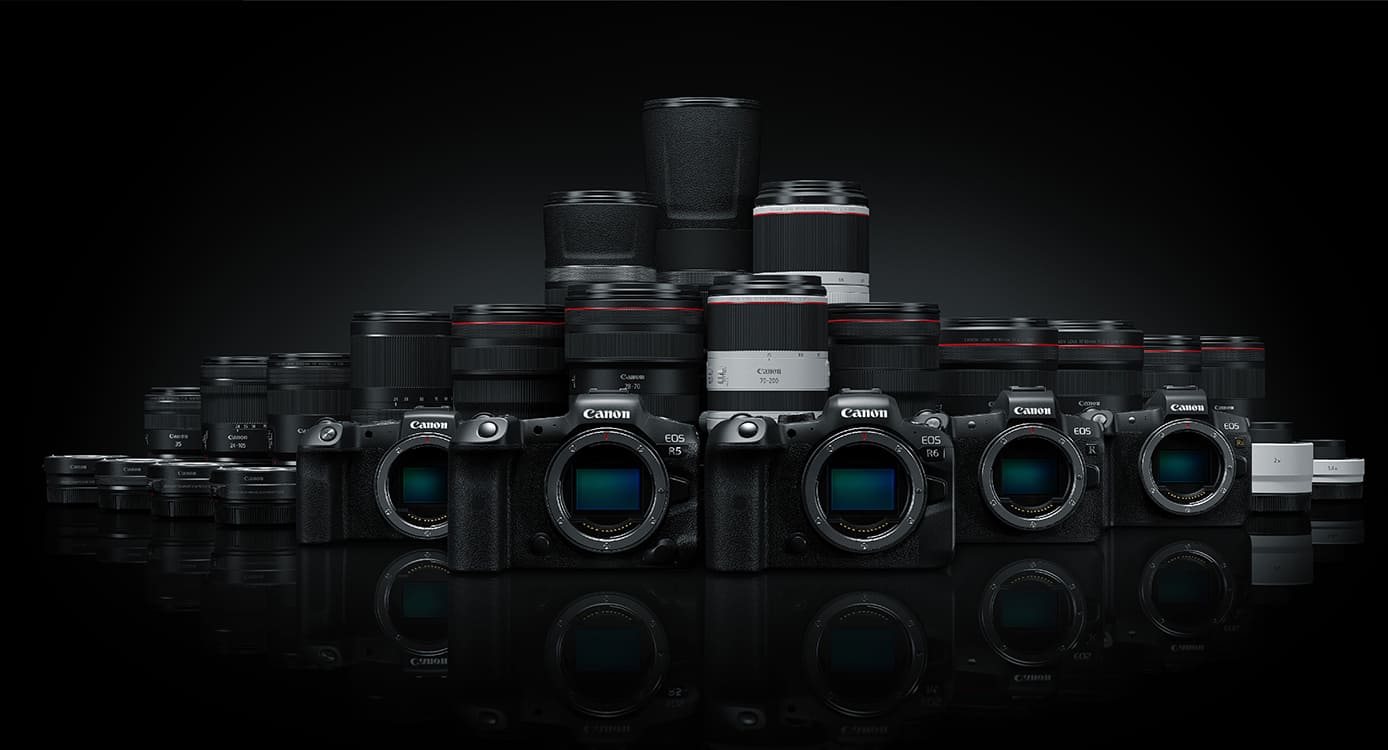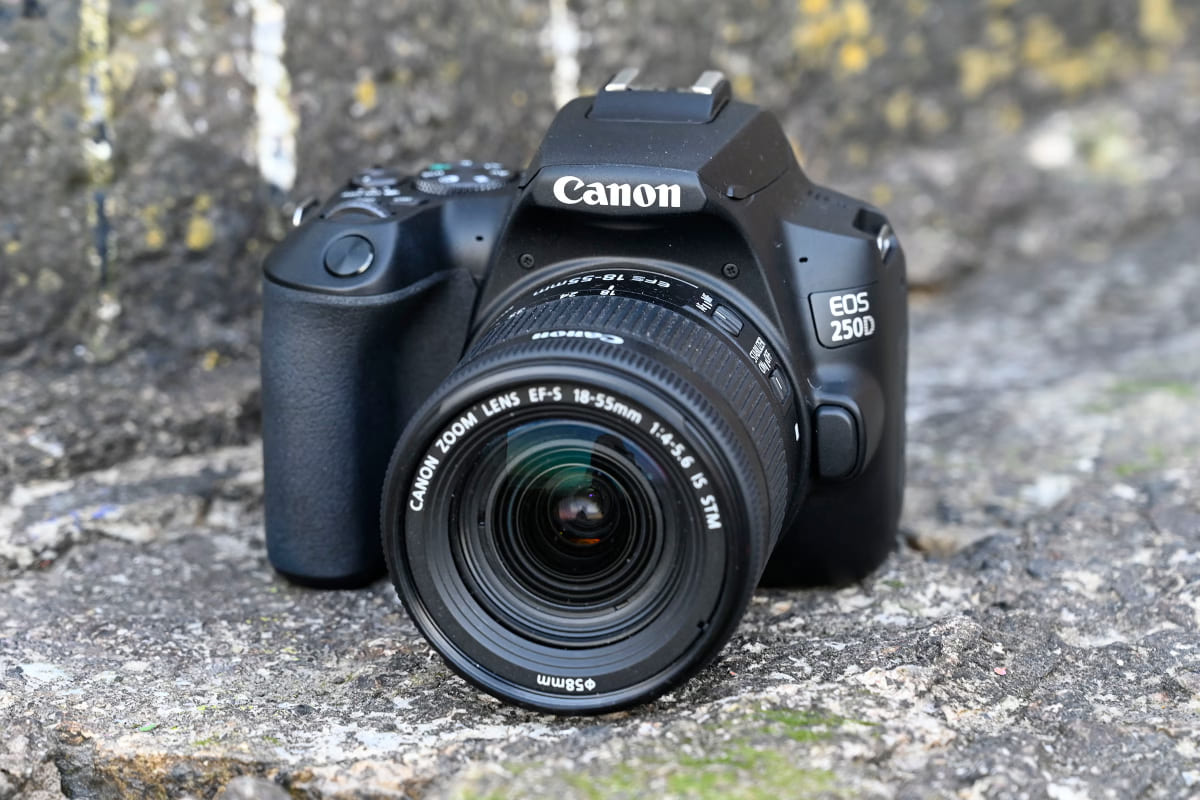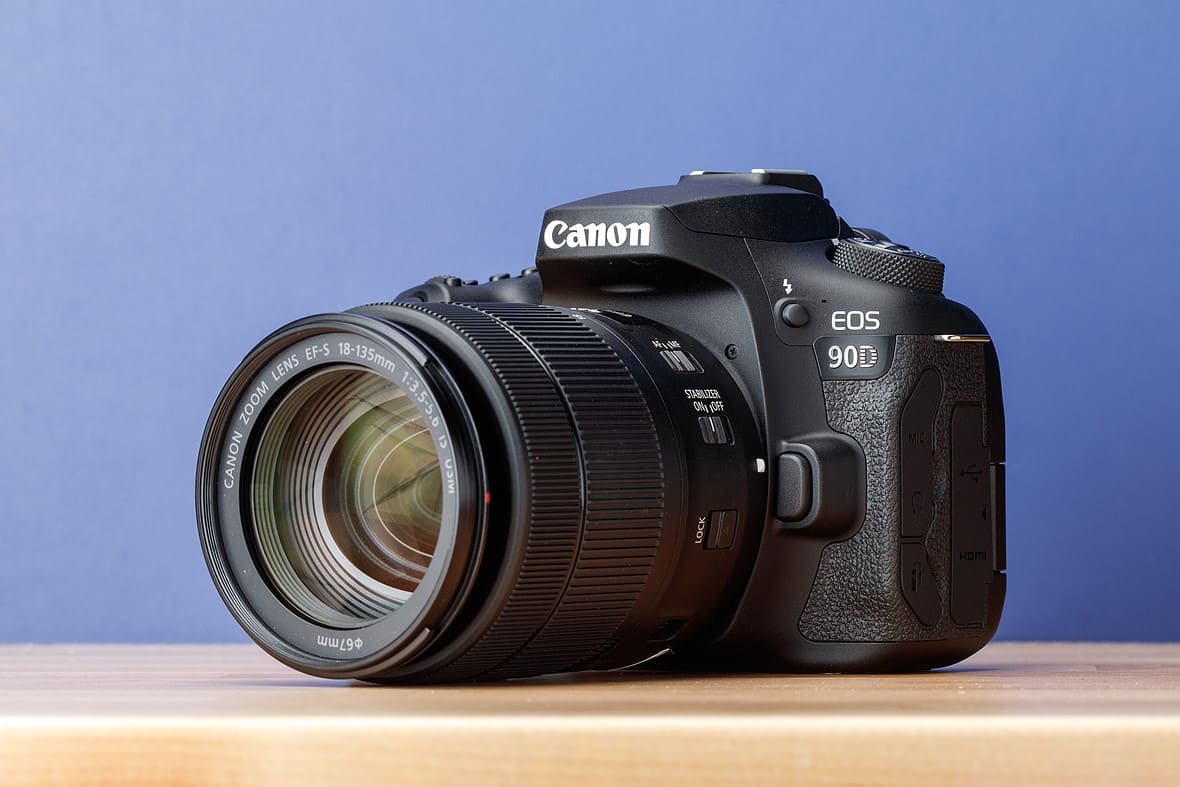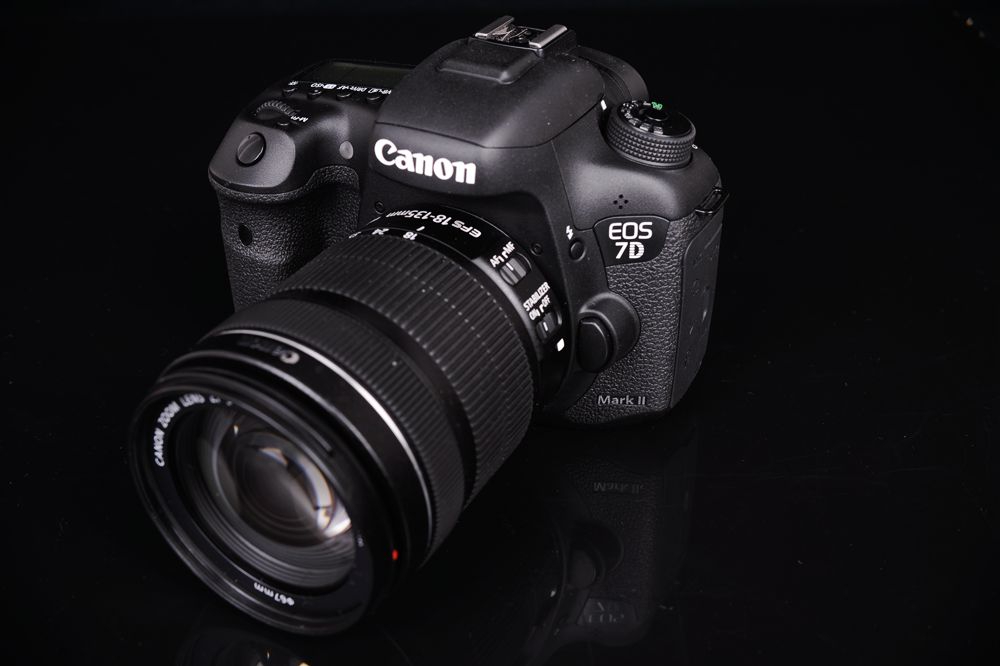Canon Camera Reviews and Buying Guide: Updated to 2025
In this article, we'll take a quick look at Canon's current range of digital cameras available on the market. We aim to provide you with a comprehensive overview of Canon cameras so that you can get a good understanding of what they offer and find the perfect camera that suits your needs.
This article is specifically designed to assist photography beginners in selecting a new Canon camera. Please note that some of the information mentioned may not apply to older models, and certain statements may not cover every single detail.
However, if you're currently considering purchasing a Canon camera, this article should be helpful to you. So, let's get started and find the perfect Canon camera for you!
This Canon camera guide was first published in January 2024 and was last updated in January 2025. We regularly update our content, so if you find the information helpful, be sure to keep following us!

In this article, you will learn:
- What Camera Lineup Does Canon Have?
- Canon EOS Camera Lineup
- Canon PowerShot Camera Lineup
- Which Is the Best Canon Camera?
- Enhancing Your Photography Experience
What Camera Lineup Does Canon Have?
Canon offers a variety of camera series to meet different photography needs and skill levels. The main Canon camera lineup can be divided into three: EOS, PowerShot, and IXUS.
EOS cameras are interchangeable lens cameras and include DSLRs and mirrorless cameras. PowerShot and IXUS cameras, on the other hand, are fixed lens cameras, also known as "compact digital cameras" or commonly referred to as "point-and-shoot cameras".
The most commonly seen Canon cameras are EOS and PowerShot cameras, which are considered more professional photography equipment.
If you are interested in learning photography and looking to purchase a Canon camera, you can choose between an EOS camera or a PowerShot camera based on whether you want the flexibility of interchangeable lenses or prefer a fixed lens setup.
On the other hand, IXUS cameras are considered entry-level consumer cameras. They have lower specifications and image quality compared to EOS and PowerShot cameras and can't even compete with the camera capabilities of smartphones right now.
The glory days of the IXUS series are in the past when smartphone cameras were not as advanced as they are today, and many families and individuals needed a simple and user-friendly camera for photography.
However, with the rapid advancements in smartphone imaging technology, the relevance of the IXUS series has diminished.
Currently, the IXUS series has almost been completely discontinued. In this context, we do not recommend purchasing an IXUS camera for learning photography.
However, if you have young children or elderly family members who do not use smartphones, buying an IXUS camera for them to play around with could still be an option (although it may be difficult to find one).
In the following sections, we will mainly focus on introducing Canon's EOS and PowerShot cameras.

Canon EOS Camera Lineup
"EOS" is actually an abbreviation for "Electro Optical System." However, this is not important because "EOS" primarily serves as a brand identifier now.
Canon has a long history of manufacturing cameras, with the first EOS camera dating back to 1987 with the release of the EOS 650, a film SLR camera. Today, EOS cameras have a history of nearly 40 years.

Currently, all Canon EOS cameras are digital cameras with interchangeable lenses, and they are divided into three series: D, M, and R.
- EOS cameras with a numeric value followed by the letter "D" are digital SLR cameras, such as the 850D, 90D, 6D Mark II, and 1D X Mark III. Canon DSLRs have had some of the most iconic and successful products in the past, but due to the rise of mirrorless cameras gradually replacing DSLRs, the Canon DSLR series has almost come to an end.
- EOS cameras starting with the letter "M" are older mirrorless cameras, such as the M200, M50, and M6 Mark II. The M mirrorless series started in 2012, focusing on compactness, affordability, and ease of use. It had high sales and received positive reviews. However, Canon later introduced the more future-oriented R mirrorless series, causing the M series to fade away.
- EOS cameras starting with the letter "R" are the newer mirrorless cameras, such as the R3, R5, and R6 Mark II. The R mirrorless series started in 2018 and is currently the main focus of Canon's imaging development and production. It encompasses Canon's most cutting-edge and powerful products.
If you are unsure about the differences and relationship between DSLRs and mirrorless cameras, feel free to read our article: Mirrorless vs DSLR Cameras.
1. Canon EOS DSLR Camera (Ending With the Letter "D")
Starting from 2003, Canon has adopted a naming convention for its DSLRs by using a combination of numbers and the letter "D". The fewer digits before the "D", the higher-end the model. For example:
- Full-frame and flagship APS-C DSLRs: such as the 5D Mark IV
- High-end APS-C DSLRs: for example, the 90D
- Mid-range APS-C DSLRs: for example, the 850D
- Entry-level APS-C DSLRs: for example, the 1500D
In this naming convention, "Mark" followed by a Roman numeral denotes the generation of the camera. So, the 5D Mark IV represents the fourth generation of the 5D series, and the 6D Mark II represents the second generation of the 6D series.
It's important to note that not all series were introduced at the same time, and their update frequencies vary. Therefore, the generation numbers should not be compared directly across different series.
For example, the 5D Mark IV is certainly more updated than the 5D Mark III, but the 6D Mark II may be more recent than the 5D Mark IV.
Here is an introduction to the product lineup of Canon EOS DSLRs:
【EOS 0000D】Entry-level APS-C DSLRs
The four-digit 0000D series started with the 1000D in 2008 and continued until the 1500D was discontinued in 2018. The four-digit series had a very affordable price point, but they used outdated components and technology, resulting in poor performance and a subpar user experience. Currently, this product line has been discontinued.
【EOS 000D】Mid-range APS-C DSLRs
The three-digit 000D series is a bit special because it includes both a mid-range three-digit series and a lower-end three-digit series.
The higher-end three-digit series started with the 300D in 2003 and continued until the 850D in 2020. The lower-end three-digit series started with the 100D in 2013 and developed until the 250D in 2019.
The three-digit series is suitable for amateur photography enthusiasts who want to experience the joy of DSLR photography without spending too much money. Even the lower-end three-digit models have relatively comprehensive features, offering much better usability and value for money compared to the four-digit models.
The higher-end three-digit models further enhance the focusing and continuous shooting experience based on the lower-end three-digit models.

【EOS 00D】High-end APS-C DSLRs
The two-digit 00D series is Canon's high-end APS-C DSLR series, starting with the 10D in 2003 and currently reaching the 90D in 2019. Almost every model in the two-digit series has been highly popular in its respective era and can be considered one of Canon's most renowned and best-selling DSLR series.
In recent years, the two-digit models have been known for their reliable and balanced performance. They may not have any groundbreaking technology, but they also do not have any noticeable weaknesses, which makes them favored by many amateur photography enthusiasts.
The latest generation, the 90D, is the highest effective pixel APS-C DSLR from Canon and delivers excellent image quality.
It offers impressive features and performance in autofocus, continuous shooting, and video capabilities. It is considered the most powerful DSLR model from Canon priced below $1500.

【EOS 0D】Full-frame DSLRs & Flagship APS-C DSLRs
1D X series and 7D series
The 1D X series is Canon's highest-end and most expensive DSLR lineup. In the past, there were also the 1D and 1D S series, but they have been discontinued.
The latest model, the 1DX Mark III, is one of the world's most powerful full-frame DSLR cameras. The 7D series, on the other hand, is Canon's highest-end APS-C DSLR series, but the latest model, the 7D Mark II, was released in 2014 and has been discontinued.
The reason we mention the 1D X and 7D series together is because they are both "speed machines," designed for fast capturing in professional settings. These cameras often have insane autofocus performance and burst shooting speeds, making them popular among sports photographers, photojournalists, and some wildlife photographers.
Of course, these professional models come with a hefty price tag. It's important to note that a high price doesn't necessarily mean they excel in every aspect. Due to their intense focus on speed, these cameras may have disadvantages in terms of image quality and pixel count.
For example, the image quality and pixel count of the 1DX Mark III fall short compared to the 5D Mark IV, and the 7D Mark II's image quality can even be surpassed by the 90D...
So, overall, amateur photographers who mainly capture everyday life or travel scenes don't need to choose cameras from the 1D X or 7D series, and portrait or still life photographers have even less reason to consider them.

5D series and 6D series
The 5D series is Canon's high-end full-frame DSLR lineup, and its second-generation model, the 5D Mark II, is perhaps the most highly acclaimed and legendary camera in Canon's digital camera history. Currently, the 5D Mark IV from 2016 is the latest generation and represents the best image quality in Canon DSLRs.
The 5D series used to have a spin-off line called the 5DS, consisting of two high-resolution cameras, but both models have been discontinued.
The 6D series is a slightly lower-end full-frame DSLR compared to the 5D series. It has decent image quality, but it comes at a cheaper price and is lighter in weight. The latest model in this series is the 6D Mark II, launched in 2017.
Note:
Both the 5D Mark IV and the 6D Mark II were once considered excellent DSLR models. However, as time has passed and mirrorless cameras have gained popularity, their features and prices are no longer as impressive.
If you are currently considering these two DSLRs, we suggest taking a look at mirrorless cameras in the same price range.
2. Canon EOS R Mirrorless Cameras (Starting With the Letter R)
In 2018, mirrorless camera technology continued to advance and mature, leading to a booming high-end mirrorless market and further squeezing the space for DSLRs. In response to this trend, Canon decided to introduce a brand new series called the EOS R mirrorless cameras.
The Canon EOS R mirrorless series is mostly identified by the letter R followed by a number. The lower the number, the higher the positioning of the camera:
- R1: Flagship full-frame model
- R3: Professional full-frame model
- R5: High-end full-frame model
- R6: Mid-range full-frame model
- R7: Flagship APS-C model
- R8: Entry-level full-frame model
- R10: Mid-range APS-C model
- R50: Mid-to-entry-level APS-C model
- R100: Entry-level APS-C model
【Canon EOS R1】
The EOS R1 series is Canon's flagship full-frame lineup. So far, it only has one model, launched in July 2024.
As Canon's top-tier and most expensive camera, the R1 stands out for its all-around excellence with no major flaws.
What truly sets it apart is its performance in continuous autofocus and high-speed burst shooting. It's also highly reliable in all kinds of shooting conditions, making it a perfect choice for professionals specializing in sports, news, or wildlife photography.
【Canon EOS R3】
The EOS R3 series is Canon's professional full-frame lineup. It currently has only one model, released in April 2021.
The EOS R3 is known for its ability to capture split-second moments and was once the go-to camera for journalists covering the Paris Olympics.
However, with the release of the newer and more powerful EOS R1 in 2024, the EOS R3 has found itself in an awkward spot — too basic for professionals and too advanced for casual users. Hopefully, we'll see an updated version in the future.
【Canon EOS R5】
The Canon EOS R5 was released in July 2020 and is a high-end full-frame model that takes over the position of the 5D series DSLRs. It competes with Sony's A7R series and Nikon's Z7 series.
Similar to the 5D series DSLRs, the Canon EOS R5 prioritizes image quality and pixel count, making it the best in terms of image quality among Canon's mirrorless camera lineup.
The R5 also boasts impressive features such as 8K RAW video capabilities, reliable autofocus, in-body image stabilization, and high-speed burst shooting. However, the R5 has faced controversy due to its tendency to overheat and shut down after prolonged high-spec video recording.
In January 2022, Canon released the R5 C, but it is not an upgraded version of the R5. The R5 C is based on the R5, utilizing the same core components, but it supports the highest video specification of 8K 60P.
Designed as a dedicated video camera, the R5 C incorporates a built-in fan to address the heat dissipation issues during high-spec video recording. It also eliminates in-body image stabilization to maintain a reasonable size and weight.
Additionally, the R5 C supports the XF-AVC professional format and features Cinema EOS video menus, as well as added professional tools like waveform monitors.
In summary, the R5 C is a professional video camera designed for professionals and is not recommended as a primary camera for photography or for beginners entering the field of photography.
【Canon EOS R6】
The first-generation Canon EOS R6 was released in July 2020 and is a mid-range full-frame model that competes with Sony's A7 series and Nikon's Z6 series.
The EOS R6 features the same processor as the EOS R5, offering comparable burst shooting speed, autofocus performance, and image stabilization.
However, it has some slight downgrades in terms of image quality, resolution, video capabilities, and build quality. Nevertheless, it is priced nearly $1500 cheaper than the R5, making it a standout in terms of value for money.
In November 2022, the EOS R6 Mark II was released. The second-generation model didn't undergo significant upgrades and the exterior design remained almost unchanged. Canon made some improvements to make the product more mature and reliable.
While this level of upgrade may not meet the needs of all photography enthusiasts, considering that the EOS R6 Mark II is not significantly more expensive than the EOS R6, it still has good competitiveness.
【Canon EOS R7】
The Canon EOS R7 was released in May 2022 and is currently Canon's highest-end APS-C mirrorless camera. It boasts high resolution, excellent autofocus, strong image stabilization, and long battery life. It excels over Canon's equivalent models like the 90D and M6 Mark II in terms of specifications.
However, the pricing of the R7 is almost on par with full-frame mirrorless cameras.
Therefore, if your primary focus is landscape or portrait photography and you don't have a specific need for professional-grade video, it's better to consider purchasing a full-frame model with superior image quality. The Canon EOS R7 is more suitable for those interested in sports events, wildlife, adorable children, and pets.
【Canon EOS R8】
The Canon EOS R8 was released in February 2023 and is an entry-level full-frame mirrorless camera. It aims to compete with budget-friendly full-frame models like the Panasonic S5 Mark II.
However, the EOS R8 boasts impressive specifications, even closely matching those of the previously mentioned EOS R6 Mark II. The main drawback of the Canon EOS R8 is the absence of in-body image stabilization.
By sacrificing in-body image stabilization, you can save $1000, making it a cost-effective deal for users with limited budgets.
【Canon EOS R10】
The Canon EOS R10 was released in May 2022 and is a mid-range APS-C model positioned slightly lower than the EOS R7.
It sacrifices high-resolution sensors and in-body image stabilization, resulting in lower burst shooting speed, battery life, viewfinder resolution, and weather resistance. However, in return, it offers a lower price and better portability.
While it may seem like it sacrifices a lot, the Canon EOS R10 still offers impressive specifications in the $800 to $1000 price range. It has a clear advantage over competitors like the Sony A6400 and Nikon Z fc, making it one of the highly recommended models in this price range.
【Canon EOS R50】
The R50 series is a mid-to-entry-level APS-C mirrorless lineup, currently with just one model, launched in February 2023.
The R50 and R100 are almost identical in size, with the R50 being slightly heavier. However, they are fundamentally different when it comes to specs and performance.
The R50 features a new sensor, a modern processor, and Canon's latest autofocus system. It delivers solid performance in image quality, autofocus, burst shooting, and video, all well-suited for its price range.
In addition, the R50's compact design, pleasing out-of-camera colors, and user-friendly interface make it a great choice for photography beginners. It's ideal for casual users looking to capture everyday moments.
【Canon EOS R100】
The EOS R100 series is Canon's entry-level APS-C mirrorless lineup. So far, it has only one model, released in May 2023, with a very low kit price.
Canon markets the EOS R100 as a "budget-friendly EOS R model," but to put it simply, it's not a great camera. It uses an old processor, outdated autofocus, has burst shooting that's almost unusable, and the 4K video is more of a gimmick than a real feature.
It doesn't even come with basics like a flip screen or a touchscreen, making it feel out of place for a 2023 release.
That said, its price drops quickly, which significantly lowers the cost of getting into Canon's mirrorless system. It's currently the cheapest APS-C camera you can buy. If your budget is really tight, it might be worth considering.
3. Canon EOS M Mirrorless (Starting With the Letter M)
In 2012, four years after the world's first mirrorless camera was introduced, Canon launched the EOS M mirrorless series. This series was designed for amateur photography enthusiasts, featuring compact and affordable camera bodies and lenses.
It was highly suitable for regular individuals and families and gained a great reputation and sales.
However, the EOS M mirrorless cameras were essentially Canon's "experimental" attempt to enter the mirrorless market. They weren't designed with long-term development in mind, and their structure wasn't built to support ongoing performance upgrades or future iterations.
With the introduction of the more powerful, advanced, and professional EOS R mirrorless series, Canon had to make the difficult decision to discontinue the EOS M mirrorless series.
Canon PowerShot Camera Lineup
The Canon PowerShot camera lineup consists entirely of fixed-lens cameras. The PowerShot cameras are divided into the relatively high-end G series and the long zoom-focused SX series.
1. Canon PowerShot G Series
The Canon G series is what most casual photography enthusiasts are familiar with when it comes to Canon compact cameras. The model names in this series are easy to understand and follow a specific formula: "PowerShot G Number A X Mark Number B," for example, PowerShot G7 X Mark III.
The Number A is written in Arabic numerals and is always an odd number (1, 3, 5, 7, 9), with lower numbers representing higher-end cameras. The Number B is written in Roman numerals and indicates the generation of the camera, for example, "III" represents the third generation in the series.
The highest-end model in this series is the G1 series, which features an APS-C sensor, the same size as Canon's mid-range DSLRs and mirrorless cameras. In theory, this series offers the best image quality among Canon's compact camera lineup.
Compared to high-end fixed-lens camera series like the Ricoh GR and Fujifilm X100, the standout feature of the Canon PowerShot G1 X Mark III is its zoom lens. While it sacrifices the shallow depth of field that a large aperture can provide, it enhances practicality.

However, since the release of the third-generation product in 2017, this series has not been updated, making it less favorable. Considering this "antique" may not be a good choice.
If the Canon G1 series focuses on image quality, the Canon G3 series focuses on long zoom capabilities. Most compact cameras have an equivalent zoom range of around 24-70mm, but the Canon G3 series can reach an impressive 24-600mm!
Even with most DSLRs and mirrorless cameras, it is difficult to achieve such a tremendous focal length.

As for the Canon PowerShot G5, G7, and G9, they are quite conventional compact cameras without any special highlights, so we don't recommend them.
2. Canon PowerShot SX Series
Although the Canon PowerShot SX series offers powerful optical zoom capabilities, it lags behind current smartphones in terms of the core sensor. As a result, its sales performance is as disappointing as the Canon IXUS cameras.
Unless you have a limited budget and an urgent need for long-zoom photography, it is not advisable to consider purchasing a Canon PowerShot SX series camera.
3. Creative and Unconventional New Products
In recent years, the Powershot lineup has introduced some products that don't fit into the traditional camera category. Two notable examples are the Powershot ZOOM and V10.
The ZOOM is described as a "monocular telephoto camera." It looks like a compact monocular, but it can capture photos and videos of what you see with a single click.
It offers just three telephoto focal lengths — 100mm, 400mm, and 800mm equivalent. However, it uses a sensor smaller than most smartphones and only delivers 12MP photos.

The V10, on the other hand, is marketed as a "lightweight and compact handheld Vlog camera." It resembles a body-worn camera but includes a flip screen and a built-in stand, making it convenient for shooting short selfie videos.
Equipped with a 1-inch sensor and a 19mm fixed lens, its concept is somewhat similar to DJI's Pocket series. However, it lacks gimbal stabilization and hasn't gained much popularity, making it unlikely to compete with DJI's Pocket lineup.

Which Is the Best Canon Camera?
After exploring all aspects of Canon cameras — both the EOS and PowerShot series — it's time to tackle the big question: Which is the best Canon camera?
Each Canon series offers unique features and performance designed to meet the needs of both professionals and hobbyists.
When it comes to choosing the best Canon camera, there's no one-size-fits-all answer. The right choice depends on your specific needs, preferences, and budget.
We hope this article has given you a clear understanding of Canon's camera lineup and the key features of each model.
As you make your decision, consider your shooting style, the features you need, and the camera's potential to grow with you. It's always helpful to test the camera yourself or seek advice from professionals or fellow photographers.
Of course, our insights might also be helpful. Once you've decided on a Canon camera, the next step is probably choosing the right Canon RF lens for your needs. Click the link below to check out our guide on Canon RF lenses for more information!
Further Reading:
Enhancing Your Photography Experience
In the final section of this Canon camera buying guide, we cannot overlook the importance of post-processing in photography. Editing your images can elevate them to new heights, bringing out the best in your shots.
To enhance your editing workflow and streamline the process, let us introduce you to TourBox.

TourBox is a revolutionary tool designed specifically for photographers and digital artists. It is a compact, ergonomic, and intuitive controller that seamlessly integrates with popular editing software such as Adobe Photoshop, Lightroom, Capture One, and more.
With TourBox, you can take full control of various editing functions, including adjusting exposure, contrast, saturation, and hue effortlessly. Its customizable buttons and rotating controls provide a tactile and efficient editing experience, allowing you to make precise adjustments with ease.

Whether you're a professional photographer or an enthusiast looking to enhance your post-processing skills, TourBox is a game-changer. It offers a more tactile and immersive editing experience, allowing you to unleash your creativity and achieve the desired results faster.